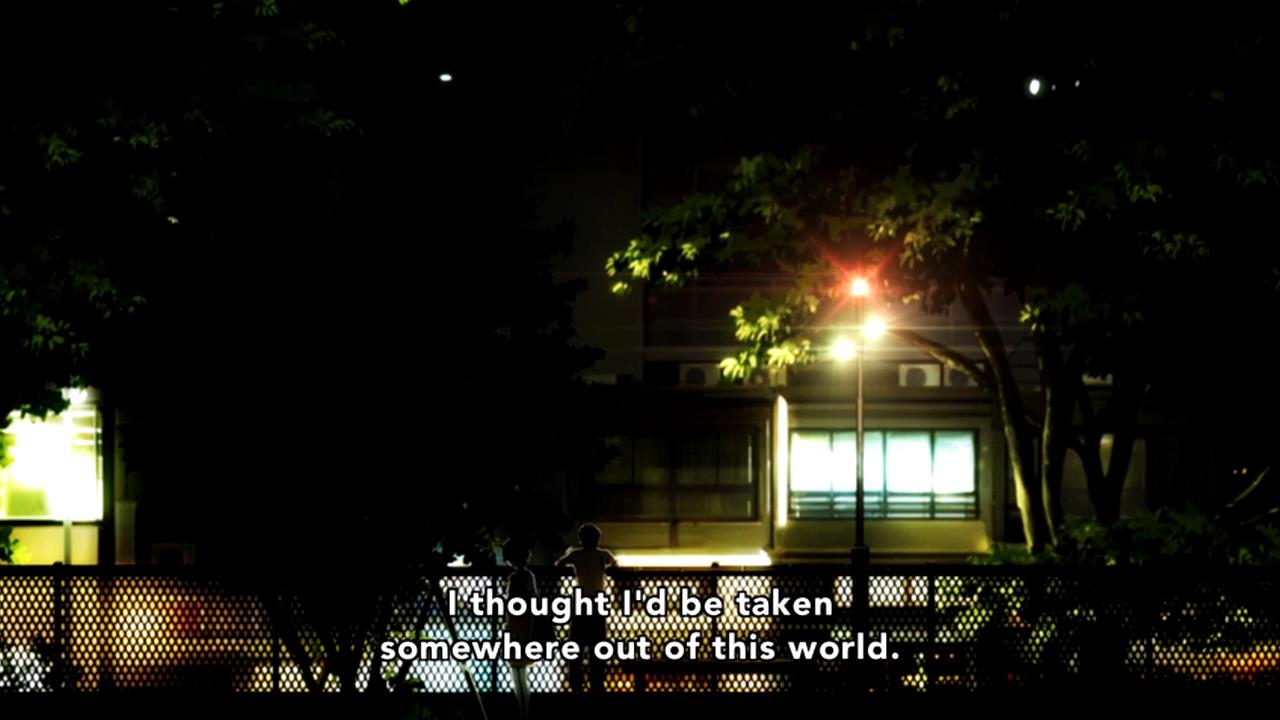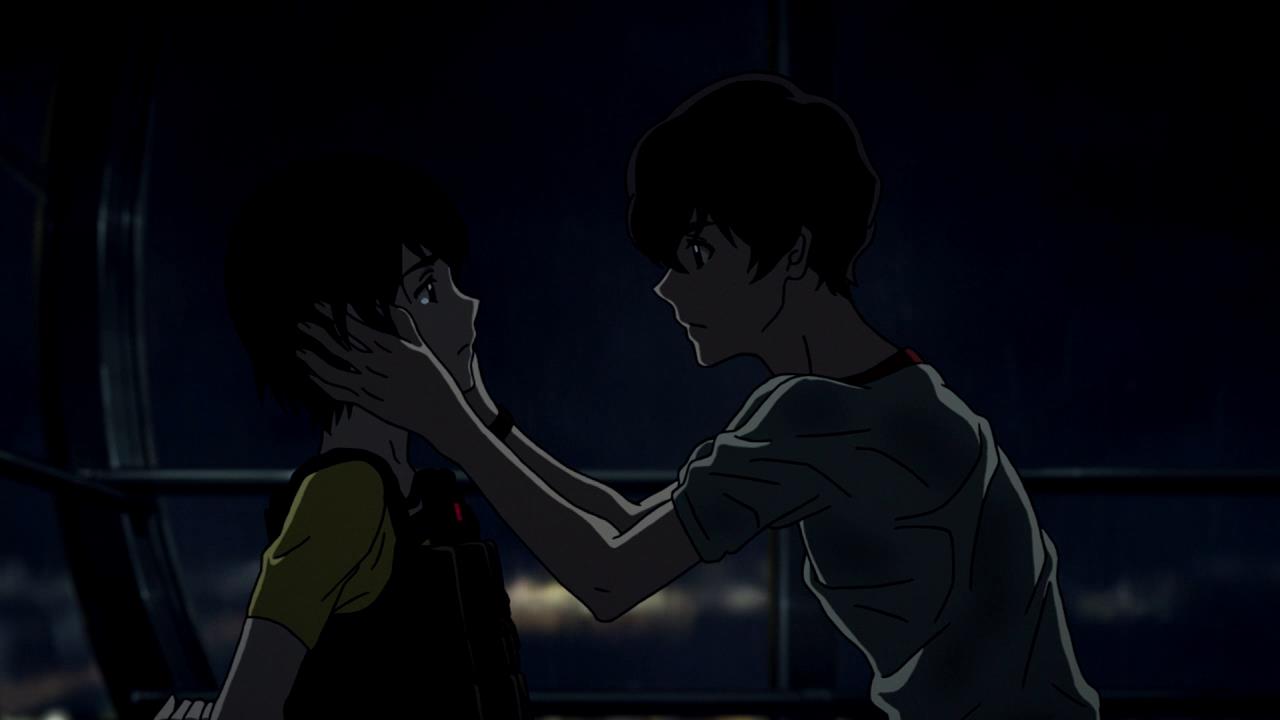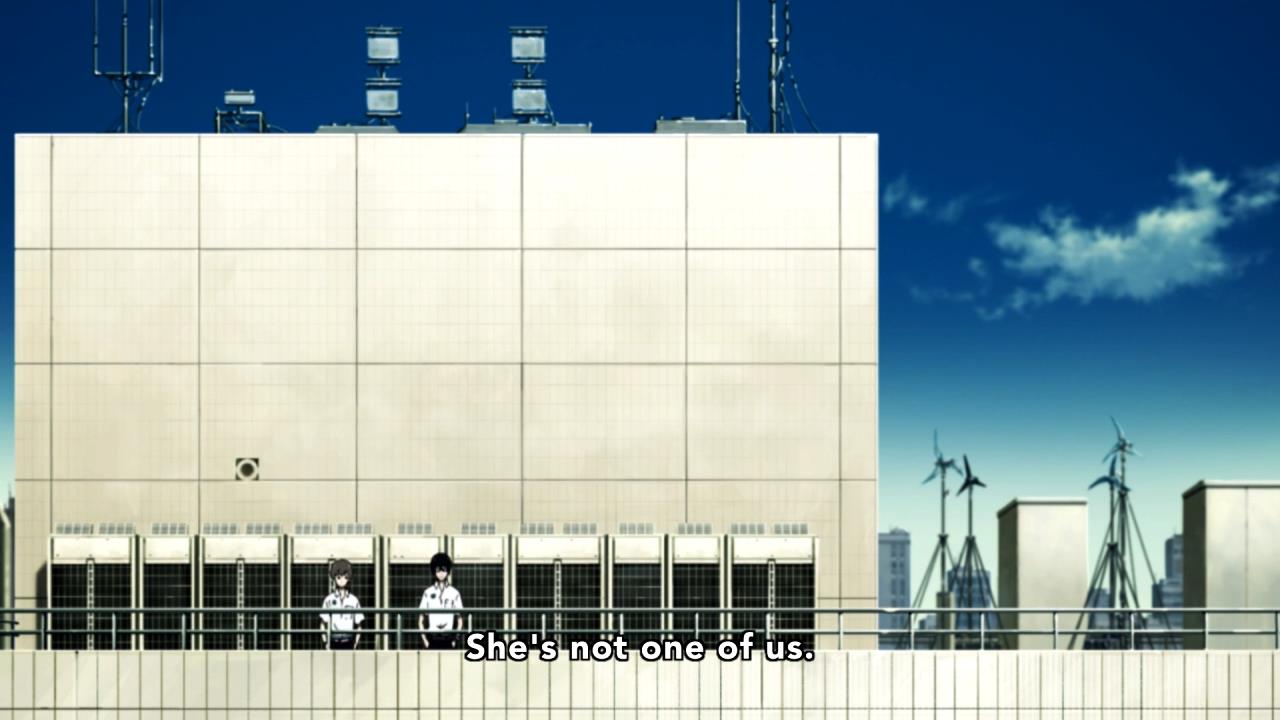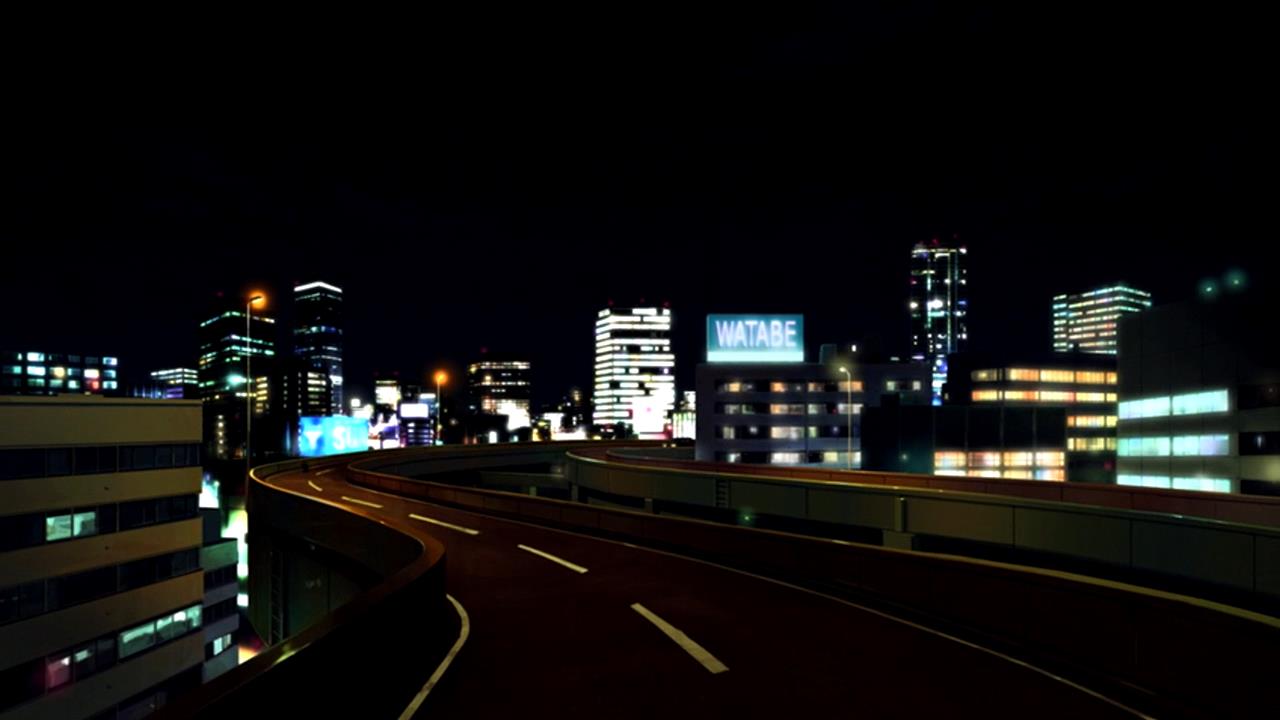“When heaven has a line around the corner,
we shouldn’t have to wait around and hope to get in
if we can carpenter a home in our heart right now
and carve a palace from within.”
– The Antlers“Tramps like us, baby we were born to run.”
– Bruce Springsteen
The world is against us, but the world is at our backs. The future could be ours, or there might just not be a future. There’s no “outside” of what we’re escaping, but we move forward anyway. Our only certainties are the wind, the darkness, and the distant horizon.
We live in the shadow of a great and terrible machine. That’s Terror in Resonance’s opening assumption; an assumption the show often takes very literally. Its characters weave in and out of society’s sunlit face and shadowed reality, and the rigidity of our modern social order is perhaps the show’s single constant antagonist. Whether they struggle against it or accept its presence, it is always there, always dictating the lives they may live. Terror in Resonance is a story of adolescent rebellion and societal alienation. It is a story of what the world demands of us, and what we become in its eyes. It is a story of anyone who is cast as a child by the world, and of the things only children can do.
Modern society demands you conform to specific roles – whether you’re a child, a detective, or even a world power, there are specific lines you are expected never to cross. For many people, all they see is the sunlight of this system – they are never rejected by the system because they never step outside of it. None of Terror in Resonance’s protagonists have this luxury, and initially, all of them represent different responses to being rejected by society’s order. Shibazaki, whose overstepping of his assigned boundaries resulted in him losing his initial authority, simply attempts to survive on the fringes, living in the shadow of his old position. Lisa, product of a broken home who’s equally rejected at home and at school, attempts to run from her world. And our young terrorists, who were never allowed even a chance of conformity, decide they are going to destroy it altogether.
Nine and Twelve don’t really want to destroy the world. They simply want to be heard, to have their grievances aired and addressed. In Terror in Resonance, the distinction between children and adults is key, and not strictly illustrated on age-based lines. Nine and Twelve are generally considered “children” in the context of the show, meaning that while their actions don’t inspire immediate counter-actions, they also aren’t listened to as full human beings. The media frames them as mysterious figures, but until they actually cause lasting harm, they’re more curiosities than dangers. Framing them as children is useful, because children can’t have legitimate complaints – if their methods turn violent, they can shift from unruly children to inscrutable terrorists without ever stopping at revolutionaries. And violence is all that Nine and Twelve have.
Over the course of Terror in Resonance, Nine and Twelve end up building an actual voice purely through the violence of their methods. They wouldn’t be listened to as children, but society reacts to violence – even if they become monsters, they’ll at least be heard. And this point isn’t strictly about how society dismisses people – even if Nine and Twelve had other methods, in the context of Terror in Resonance, it seems like people can only express their emotions through the tools they’ve been taught. Even Nine and Twelve’s sentimental moments are expressed through the violence they’ve been raised on – Twelve’s most intimate moment with Lisa is framed as a bomb defusal, and his making up with Nine is bought on the back of a grenade. Their childhood associate Five, who seems inspired only by her need to reconnect with the pair, is also constrained by the tools she’s known, and can only express herself through violent opposition. And this point extends upwards to the show’s highest levels, as even the program that created these children is framed as a nationalistic response by Japan to the oppressive treatment of the United States. Those treated as children have no voice, those treated with violence have no other tools. Embracing violence means throwing away your chance at happiness within society’s structure – but in the context of Nine and Twelve, that’s actually a part of their power.
People are naturally predisposed to find some peace within society’s strictures. We find love, we make friends, we discover some small fragment of family and settle down. Throughout Terror in Resonance, this tension is continuously brought into the frame – Shibazaki’s allies weigh their convictions against their stable family life, and Shibazaki himself only gains the ability to force change at the cost of his remaining professional ties. Rebellion is intrinsically tied to youth not just because young people are the only ones who can imagine altering society’s frame altogether, but also because they’re the ones who feel they have the least to lose. That’s what makes Nine and Twelve so initially powerful – as abandoned children, they are untethered, and can sacrifice themselves for the cause. They can wager everything because they have nothing but each other.
That distance doesn’t last, though. Even through their violent actions, the demeanor of Nine and Twelve make it clear that they are at their happiest when they are making true connections – Nine through his strange correspondence with Shibazaki, and Twelve through his relationship with Lisa. Lisa’s presence changes Twelve, and each of them give the other an element of family, an idea of home. Lisa’s faith in both of them, and continued insistence on treating them like family, “weakens” their convictions, and demonstrates that they actually are children – but not in the way the media portrayed. People can be young without being wrong, even if their hopes and ideals seem impossibly optimistic, their methods disastrously naive. Resonance’s framing is always somewhat childish, because this is a story about childhood ambitions – but in the end, hope is itself always a reflection of impractical optimism. Only a child could feel the wind catch their hair and believe they might truly be free.
You can’t actually run away from the world, and if you try to change it, you’ll probably fail. But Resonance’s best moments don’t really care about the practicality of its politics – they care about the fundamental truth of its characters’ feelings. Out of all of Resonance’s dramatic peaks, the moment that most sticks with me is Twelve gunning his motorcycle and racing to Lisa’s rescue, carrying her off into the distance. The structures that have solidified into our modern society are inescapable, but in a moment like that, you could almost believe that we might burn it all down. The wind at your back. The cool air past your face. And before you, the dark, starlit road, spiraling out to the horizon.





The Springsteen quote at the start of the article reminded me of another teenage terrorist – Battle Royale’s Nanahara Shuya. The orginal novel, as far as I can remember, ends with that Springsteen quote.
I don’t think the sequel movie did a particularly good job at… well, at much, really (it’s a flawed but obviously emotionally-raw tribute to Kenta Fukasaku’s father) but it’s been years since I’ve seen BRII and I wonder how its portrayal of ignored youth’s lashing out at a society that’s abandoned them sits next to Terror in Resonance.
Yeah, the novel had Springsteen references all throughout. Never saw the sequel, though.
Pingback: Beyond Terrorism | Terror in Resonance, A Review | therefore it is
Great article, really hits home on the themes and message of the show. It had alot of flaws, yeah, like the character development, the pacing, and the lack of a society point of view of the acts of terrorism, but it managed to convey it’s themes really well.
It sure is nice to see an actually positive write-up for this show. Great work as always, Bob. Our reads of Zantero ended up being pretty similar, I think. At least I know I’m not totally alone over here in Crazytown! Though, I do think the social-structure boogeyman that looms over Zentero’s story is less generally societal and more specifically familial, even distinctly paternal. The story invokes the idea of patricide and the social responsibility of fathers far too often for me not to assume it’s an important thread. I’m not sure it’s a coincidence that the disappearance of Lisa’s father is basically the root of her alienation and disillusion, or that most of the non-evil adult male characters are shown to be earnest fathers. This show gives me the impression that one or more people on the production crew didn’t exactly have a great relationship with their father or grandfather.
I also agree with what you said in your reddit post about Zantero playing more like a conventional thriller than is actually is; that’s definitely one of my chief criticisms of the show as a whole. Though I do generally enjoy the kinds of thrillers that Zantero tries to be. My initial impressions of Zantero were “Penguindrum by way of James Patterson novel”, and while I rather like that idea conceptually, I think the structure ultimately hamstrings a lot of what the show was actually trying to do.
Anyways, great piece. I hope this won’t be the last full-series write-up now that you’ve got so much work over at ANN.
If it were just a bit more graceful of a thriller, I think it would come together much more effectively for most people. It’s a shame – I don’t think this structure is inherently flawed, I just think this particular show didn’t quite get there.
Great write up. I loved the motorcycle scene too, although by far my favorite part of the show was the ferris wheel sequence. Since we knew Nine and Twelve weren’t likely to live, it made that whole scene genuinely intense. There was a real risk Lisa and Twelve could die. While Resonance is a flawed show, it still had several moments where the music, visuals, and narrative all intersected to make a truly spellbinding scene. Kudos to Watanabe, Kanno, and MAPPA.
Yeah, the ferris wheel scene was another of my favorites. Definitely one of the show highlights.
I honestly didn’t like this show. I don’t think your essay here changes that, to be honest. Despite that, it did make me think, and that’s what you get paid the big bucks to do, right? …you do get paid, right? D:
Cause you should.
Not for this stuff! I get paid for my ANN work, though.
Reblogged this on compass on my field trip.
I’m actually pretty surprised by a lot of the negative criticism people are mentioning. I found it to be pretty much flawless up until Five came in and hijacked the whole story with her god awful “igirisu” which shouldn’t have happened seeing how Space Dandy, Watanabe’s previous work, was released in English BEFORE Japanese. I thought the whole “Shadow of the Machine” focus was pretty analogous to the crime syndicate shadowing controlling society present throughout Bebop, and it makes me think that Terror’s story would’ve been more easily ingested by those who seem to have deplored its controversial political statements had it been wrapped in something like Bebop’s futuristic and stylized setting.